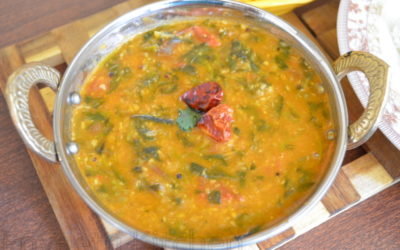THOGAYAL (CHUTNEYS)
The word “chutney” is derived from the Tamil word catni meaning to eat with appetite. In India, “chutney” refers to fresh and pickled preparations. Several Indian languages use the word for fresh preparations only. In Tamil Nadu, thogayal or thuvayal (Tamil) are chutneys with a pasty consistency. In Andhra Pradesh it is called roti pacchadi. In Telangana the same is tokku.
Quite a few vegetables and plants have medicinal values, as per Ayurveda. These are made into chutneys and served as dips with main courses such as dosas, idlis, etc. For e.g. Pirandai Thuvayal or ridged gourd chutney (Peerkangai Thuvayal or beerakaaya tokku). Bitter gourd, a vegetable high in medicinal value, especially for diabetes, is made palatable by serving it as a chutney as a side dish in meals. Another popular chutney, particularly in the states of Andhra Pradesh and Telangana is the gongura leaves chutney.
Occasionally, chutneys that contrast in taste and colour are served together—a favourite combination being a green mint and chili chutney with a contrasting sweet brown tamarind and date chutney served with widely popular Indian snacks called chaat.
Podi
In South India, especially in the state of Tamil Nadu, Andhra Pradesh, Karnataka and Telangana, besides the wet chutneys, there are a wide range of chutneys ground into powders. Popularly called Podi, meaning powder, they use a combination of roasted lentils, sesame seeds, peanuts, dried coconut, red chillies, curry leaves, etc. Podis make a great relish for popular South Indian snacks dosa, idli, adai, etc.
Preparation
Chutneys are ground with a mortar and pestle or an ammikkal (Tamil). Spices are added and ground, usually in a particular order; the wet paste thus made is sautéed in vegetable oil, usually gingelly (sesame) or peanut oil. These days, electric blenders or food processors are used as labor- saving alternatives to stone grinding. However, to truly bring out flavors of spices, herbs, and other such ingredients, stone grinding is the best. All recipes in the Bhaga Shastra only recommend stone
grinding or pounding (where possible).
Ingredients
Basic ingredients in a chutney include roasted gram cumin seeds, fresh coconut, a souring agent like tamarind and salt all of which are stone ground to a coarse or fine paste. However, a variety of spices and herbs can be added to make a lip smacking array of chutneys. Spices commonly used in chutneys include fenugreek, coriander, and asafoetida (hing). Other prominent ingredients and combinations include cilantro, capsicum, mint (coriander and mint chutneys are hara or green chutney).
Some varieties of chutneys include tamarind or Imli (meethi or sweet chutney) sooth (or saunth, made with dates and ginger), coconut, onion, prune, tomato, red chili, green chili, mango, lime, coconut, peanut, dahi, green tomato, dhaniya pudina (cilantro and mint), peanut (shengdana chutney in Marathi), ginger, dahi (yogurt), red chili powder, tomato onion chutney, cilantro, mint coconut chutney, etc.
https://en.wikipedia.org/wiki/Chutney – refer to the long and wide variety of Chutneys across various regions of India.
PULIYANKAI THOKKU (SOUR THOKKU)

Ingredients:
Tamarind – 5 veesai
Salt – 1 and ¼ padi
Turmeric powder – 1 and ¼ palam
Red chillies – 5 palam
Fenugreek – ¼ palam
Mustard – 1 palam
Urad dal – ½ palam
Asafetida – ¼ palam
Method:
● The tamarind fruit has to be raw or about to ripe. Take 5 veesai of this fruit. Add salt to the tamarind fruit and pound well. Add turmeric powder to the pounded tamarind, mix well and grind it again. Put this in a mud pot or a coated vessel and after two days remove the seeds and veins. Then pound it again and set aside. This pound item can be kept for a year. One week’s portion of this item can be removed separately in a smaller mud pot for use. This portion can be further improved as follows:
● Heat sesame oil in a pan. Put red chillies in the oil and fry until brown and remove the chillies and set aside. Refer to recipe no. 22 (seasoning recipe) seasoning method and use fenugreek, mustard, urad dal to season this dish.
● Crush asafetida and put this in the seasoning. Pound the chillies and the asafetida. Take ½ veesai of the tamarind thokku and put the asafetida and chillies in it. Mix well and pound it again and add the seasoning to it.
● Green chillies can be used instead of red chillies. This is done during the season of the tamarind fruit.





0 Comments